If you’re thinking of trying out a new garden design, you may have heard of vertical gardening. This design has become popular in recent years because of its versatility and space-saving capabilities, especially for those with small outdoor spaces or who want to create a garden indoors.
Vertical gardens have been used since ancient times, & often use hydroponics to deliver water & nutrients to plants. Vertical gardens can increase crop yields, & improve air quality by removing pollutants. Edible plants grown vertically include: peas, tomatoes, squash, grapes, strawberries, lettuces, & herbs. Ornamentals used in vertical gardens include ferns, orchids, & pothos.
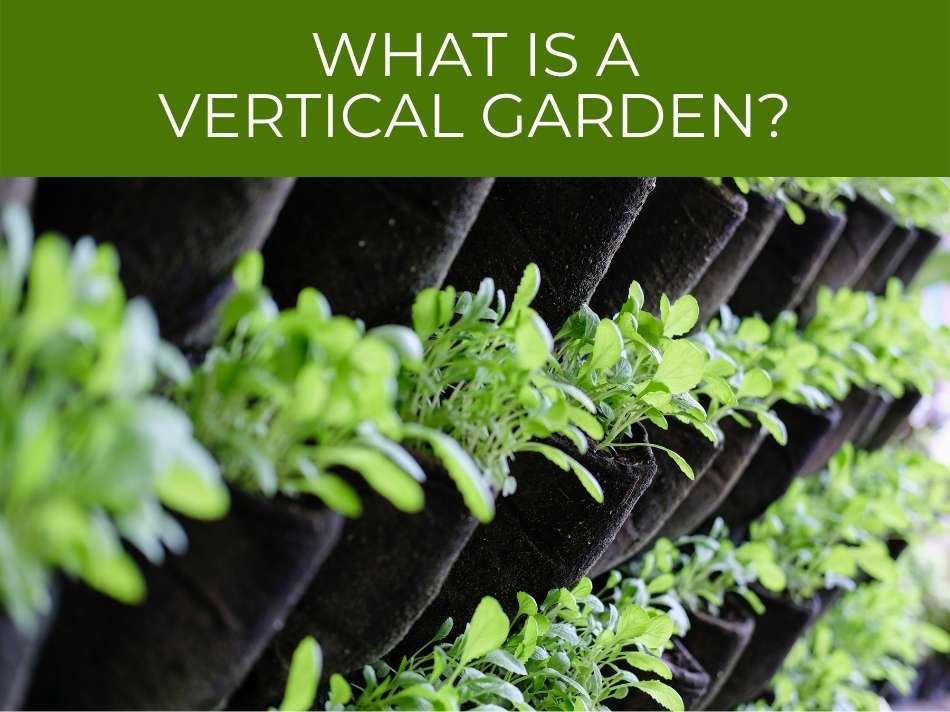
What is vertical gardening?
Vertical gardens have been around a long time. The Hanging Gardens of Bablyon–one of the seven wonders of the ancient world–were a form of vertical gardening.
Essentially, vertical gardening is exactly what it sounds like: growing things vertically! The most common version of this that you may already have in your garden is a trellis around which vines can grow. However, there are many different ways to build a vertical garden. Some possible ways are by building a garden up against a wall, using shelves, using pallets or recycled containers, or mounting pots.
Hardware and gardening stores sell vertical garden kits that are already put together for you, or you can choose to build one yourself. We’ll go into more detail about this later, but for now let’s learn some more basics of vertical gardening!
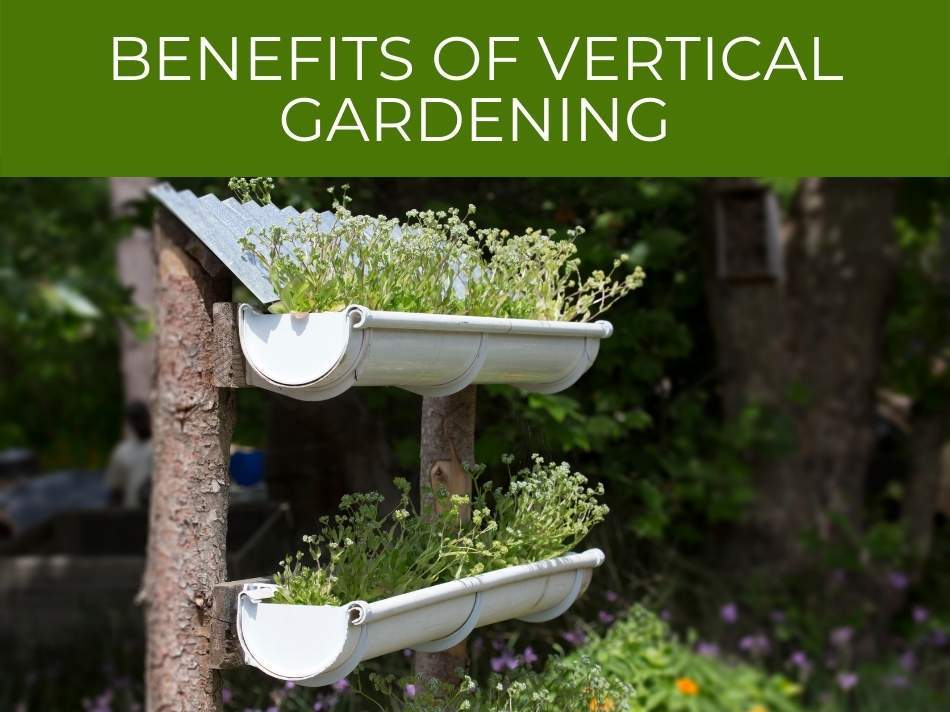
Benefits of vertical gardening
If you’re considering a vertical garden, you’ll want to be able to weigh the benefits and drawbacks and see what’s right for you and if this type of garden will meet your needs. Not every design is for everyone, and you definitely want to grow a garden that’s right for you! Let’s start with some benefits.
Saving space
Because you’ll be building up instead of out, vertical gardens don’t require very much space. If your outdoor space is small, you don’t have a lot of room for a garden, or you want an indoor garden that won’t get in your way, this is a great option. The gardens themselves can be as big or small as you want them to be, so you can easily find or build something that will fit in whatever space you’ve got. Especially for city folks in apartments, vertical gardens have become a way to experience the beauty and enjoyment of gardening even in a small space.
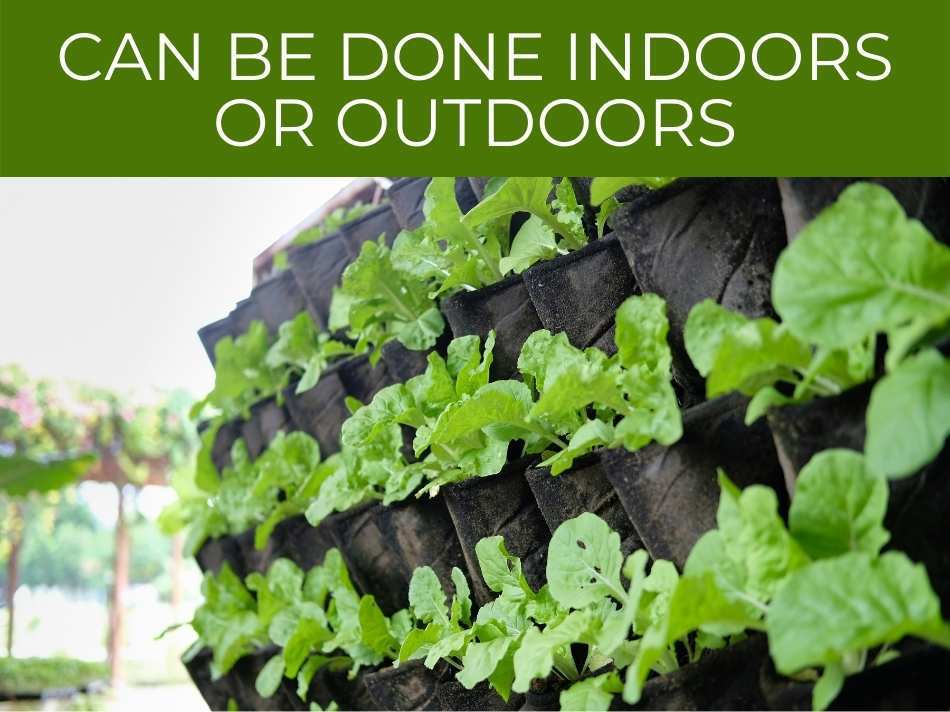
Can be done indoors or outdoors
Like we just mentioned, vertical gardens can work inside or outside. This is great for many reasons. You may not have an outdoor space, or maybe you want to grow year-round, so you could build your vertical garden indoors. Or, if you’re looking to dress up your outdoor space or create something new, these gardens are perfectly suited to be outside too. They’re really versatile and can work wherever you want them to be.
Cover up parts of the living space or outdoor area that don’t appeal to you
Everyone has a part of their living space that they don’t like very much. Maybe you’ve got an ugly wall or an awkward space you don’t know what to do with. Enter the vertical garden! Rather than buying a piece of art or mustering the strength and patience to paint that wall, you can add beauty and life pretty easily with the vertical garden. And since it’s customizable to you and what you want to grow, it’s much more personal and will likely be more satisfying than a new paint job. It’s a fun and easy way to cover up an area that’s giving you trouble.
Allowing for creativity
Because of the various ways you can build a vertical garden and the kinds of plants you can grow, adding a vertical garden is a way to express your creativity and try out something new. There are tips for having a successful vertical garden (we’ll get into those later on), but other than that, the constraints are pretty minimal. You can find so many different designs or design it yourself, and you can bring in color and various materials that fit within your vision. It’s a great alternative to pots and beds for those who want to try something a little less traditional and bring in a unique element.
You can use soil or grow hydroponically
A vertical garden is a great opportunity to try out hydroponic gardening, which is gardening without soil. This is a great option especially for an indoor vertical garden, but if you’re interested in hydroponics, you can do this inside or outside. And if you lean more toward soil gardening, that’s great too – vertical gardens are easily adaptable to each technique.
Reducing back and knee pain
We’ve all had those days after being bent over in the garden where everything hurts. Gardening is one of the greatest hobbies, but it can be really hard on our bodies, especially our knees and our backs. Vertical gardening can eliminate a lot of that pain because it won’t require you to bend or kneel. You’ll still get all the enjoyment of gardening without the aching and the need to lie down on a heating pad!
Reduced risk of pests and infections
There’s a possibility that by incorporating a vertical garden, you can lower the risks of pests and infections in your plants. There isn’t a definitive answer on whether or not this is true, but many vertical gardeners have found that their vertical gardens attract fewer pests and in general, the plants are very healthy and not as prone to infection.
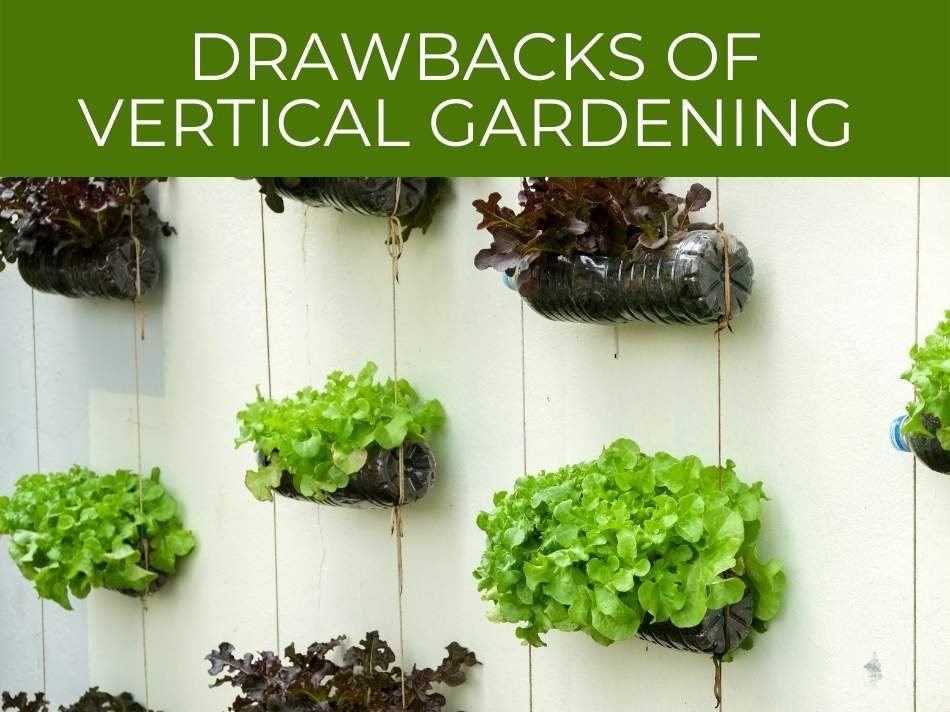
Drawbacks of vertical gardening
There are a lot of benefits to vertical gardening, but no technique is perfect. To really be able to decide if a vertical garden is a good option for you, it’s important to understand the potential drawbacks of a vertical gardening system.
Moisture and mold issues
One drawback of vertical gardening is a potential for moisture and mold issues, especially if your garden is built into a wall. In a garden on the ground, water simply drains into the ground, but with vertical gardens, any excess water could potentially soak into the wall. This can cause water damage over time.
Mold is an issue that tends to go hand in hand with water damage because mold thrives in those stagnant, wet environments. You’ll want to be on the lookout for any mold.
That being said, if you are watering your plants the right amount, the potential for water damage decreases because the plants are soaking up the water they need. Also, some vertical gardens aren’t built into the wall and therefore can drain more easily, and with those, there’s definitely less potential for water damage and mold.
Issues with light
Another potential issue with vertical gardens is making sure all your plants are getting adequate light. Because the plants are sort of stacked on top of each other, the plants that are higher up have the potential to block light from the plants below them when they create shadows. There are two ways to overcome this issue. First, you could use plants that are all about the same height so that the plants on top don’t create shadows that would greatly affect those below them. The other solution would be to organize your plants based on how much light they need, and plant the ones that need the least light toward the bottom and the ones that need the most toward the top.
Light is always a difficult balance for plants because of the various amounts that different plants need and also because of the access to light that you may have in your outdoor space. But with some research and some thought about the right location for your plants, you can make sure that your plants get the amount they need.
Won’t accommodate all plant types
If you have plans to grow specific plants, a vertical garden may not be the best option for you because not all plants will thrive in this design. Specifically, plants that are heavier, such as larger fruits and vegetables, are difficult to grow in a vertical garden. You can still grow produce in vertical gardens, but the items you want to grow may do better in a bed or a pot on the ground.
Cost
Depending on what kind of structure you choose to use for your vertical garden and also which plants you want to grow, you might find that a vertical garden ends up being more expensive than a traditional in-ground garden would be. This is especially true if you decide to buy a premade structure. Also, you may find that some of the plants that will work best for you in a vertical garden are on the pricier side. Cost is always an important factor to consider, so we wanted to be transparent about initial costs you might incur.
May be higher maintenance
Because you are growing a garden up and not out, vertical gardens might end up being higher maintenance. If you want a manicured look, you will probably have to prune more often than you would with a traditional garden. Plants look floppy a lot more quickly when they’re hanging from a wall than they do when they’re in the ground! This, of course, all depends on what you decide to plant. You may find that you don’t have to maintain your plants very much after all.
Plus, although there might be more pruning, there will definitely be less weeding. Weeds won’t grow in your vertical garden as they would in a traditional garden, so you could think of it as trading out one kind of maintenance for another.
|
Benefits of vertical gardens | Drawbacks of vertical gardens |
|
|
Now that you’ve gotten an idea of the benefits and drawbacks of a vertical gardening system, it’s time to decide if this feels right for you. If it does, it’s time for the fun part! You can now get creative in thinking about your design and what you want to plant, and then you can actually build this thing and get to growing.
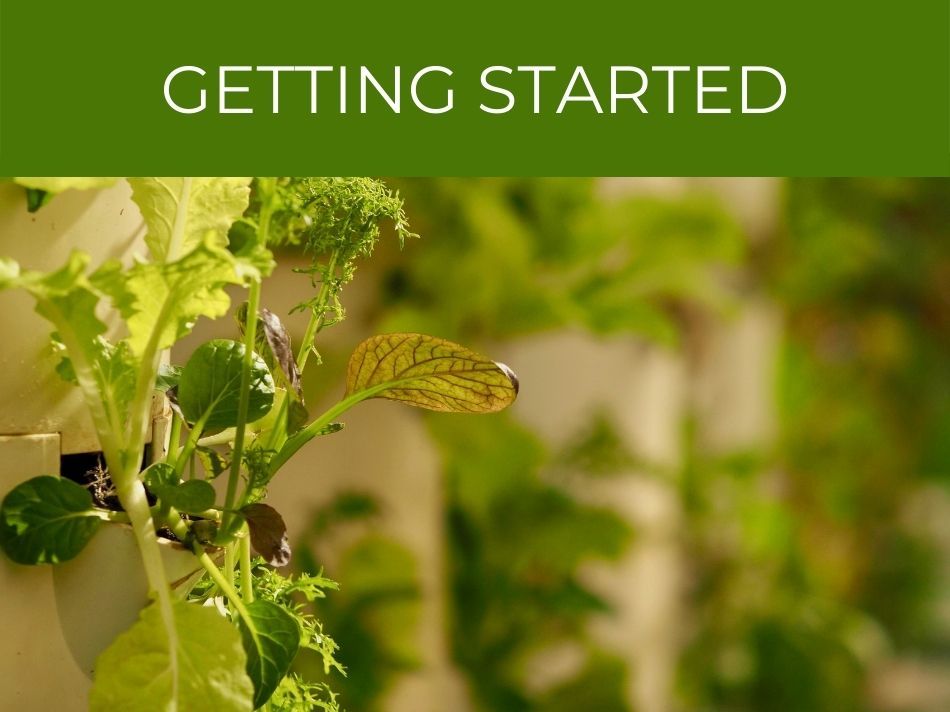
Getting started
Even after deciding that a vertical garden is something you’d like to try, it may be a bit daunting. Here are some ways to break this process down into smaller steps and help you create the vertical garden of your dreams.
Choose the space for and size of the garden
The first step you’ll need to take is figuring out a location for the garden. As we mentioned above, you might already have a place in mind. Maybe there’s a wall you’re trying to cover up or a place in your outdoor space that could use some extra color. Wherever you decide to create your garden, you’ll want to consider the amount of light your plants will get. Luckily, you can find plants that will grow in different amounts of light, so if you have a spot in mind, you’ll just want to cater your plant choice to the amount of light that your space gets. If you have particular plants in mind, you can look up how much light they need and pick a space accordingly.
You’ll also want to have a ballpark size in mind. Again, if you already have a space picked out, you know the approximate size that your garden can be. If you don’t, consider what you want to plant, how much room those plants need, and how much work you want to do. The bigger the garden, the more maintenance it requires, so this is a good thing to keep in mind as you’re figuring out the size of your garden.
Decide on a DIY versus a premade structure
After you decide where and how big you want your vertical garden to be, you can decide whether you want this to be a DIY project or if you want to buy a premade vertical garden structure. You could also do a combination of the two – buying a structure and adding onto it or painting it to make it your own.
It’s worth browsing online or taking a trip to your local hardware or garden store to see what kinds of options are out there. You might find a structure that really matches what you’re looking for and will fit nicely in your space, or you might realize that building the garden yourself is the way to go. There aren’t necessarily advantages of one or the other as much as
This is the part where your own personal preferences and style come into play the most – it’s completely up to you in terms of how you want your garden to look and how big of a project you want to make this!
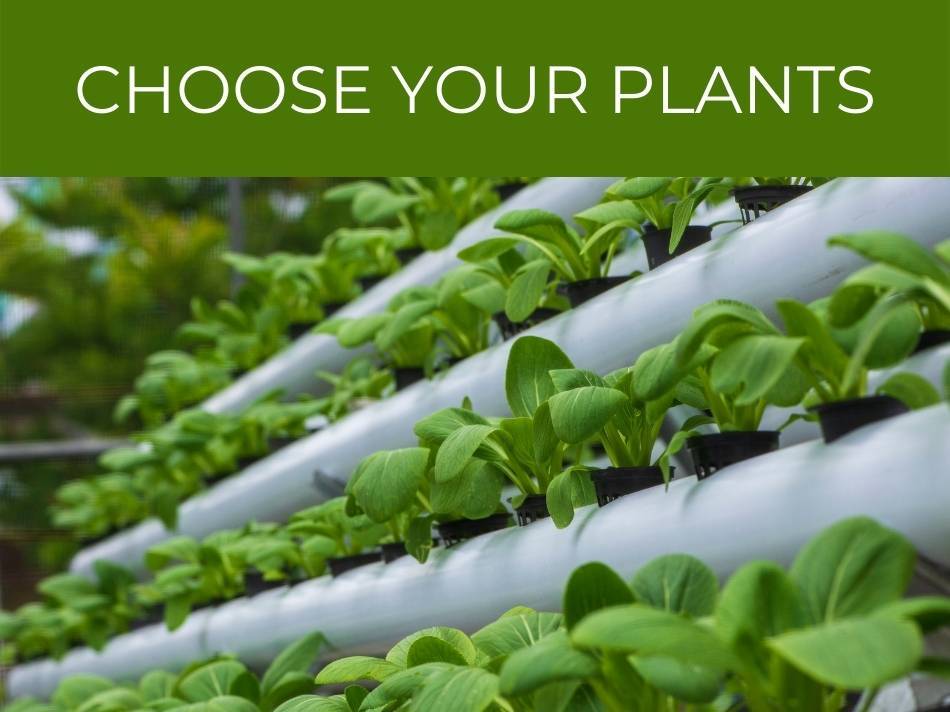
Choose your plants
After you have your structure mapped out, you can choose your plants! This is another really fun step where you get to envision your garden coming together and adding beauty to your space. Something to note: you could also choose your plants before figuring out your structure – that way, you’ll have an idea of how much space you need to accommodate the plants you choose. This is kind of up to you – if you have plants picked out, you can find a structure to accommodate them. If you have a particular structure in mind, you can pick plants that’ll work well for your structure. It’s up to you and your preferences! Below you’ll find some more tips for choosing your plants.
Choosing your plants
No matter what kind of garden you’re looking to grow, there are always several factors you want to consider. The main things you’ll want to figure out are what kinds of plants grow well in your area and what your gardening goals are.
Consider what grows well in your area
When looking at what you want to grow, it’s a good idea to pick plants that grow well where you’re located. A great option is to find plants that are native to your state or your region, as they have adapted well to the climate you live in. If there aren’t any native plants that strike your fancy, never fear! You should just be looking at factors like water availability in your area and the amount of water the plants will need, the weather in your area, and the amount of light that the plants you want to grow will need. If you’re able to create the ideal growing conditions for the plants you pick out, you’ll have a flourishing garden!
Consider what kinds of plants you want to grow
Another factor you’ll want to think about is the function of your garden. Are you looking to add some color and variety to a space, or are you hoping to grow produce in your garden? Maybe it’s a combination of both. Once you figure that out, picking out your plants becomes a lot easier. You can look at different colors that appeal to you or at different fruits or vegetables that you like to eat or cook with.
Something to keep in mind is that as we mentioned above, heavier plants tend to not work as well in vertical gardens, so it’s best to choose produce options that are lighter if you go the produce route. Also, some plants have larger root systems than others and need more room to grow, so definitely keep that in mind too when you’re picking out your plants. You want every plant to have enough space to thrive!
Building your garden
Okay, you’ve chosen your location, your plants, and your structure. It’s time to build your garden! The process for this will be different depending on what type of vertical garden you’ve chosen. If you’ve chosen to buy a premade structure, this step is really quite easy! You’ll just pick out your structure and do any assembly required and then set it up in the space you’ve picked out.
DIY vertical gardening
If you choose to build your garden yourself, this step will take a bit more time, but you’ve got this! Common materials to use for DIY vertical gardens are pallets and two-by-fours, but this is actually a really cool opportunity to see if you’ve got any spare materials around your house that could work for a garden. This step is pretty personal to you and your space and your preference for materials, so the most important things to keep in mind are the size and location of your garden, what you’ll be planting, and how the water will drain from your garden. If you plan ahead for water drainage, you’ll be less likely to face the water damage and mold issues we mentioned earlier.
Combining premade with DIY
Vertical gardening is a great way to combine some DIY with premade materials if you aren’t leaning toward one option or another. There are tons of different structures you can buy and then make your own, including shelves, ladders, and pots that can adhere to walls and other surfaces.
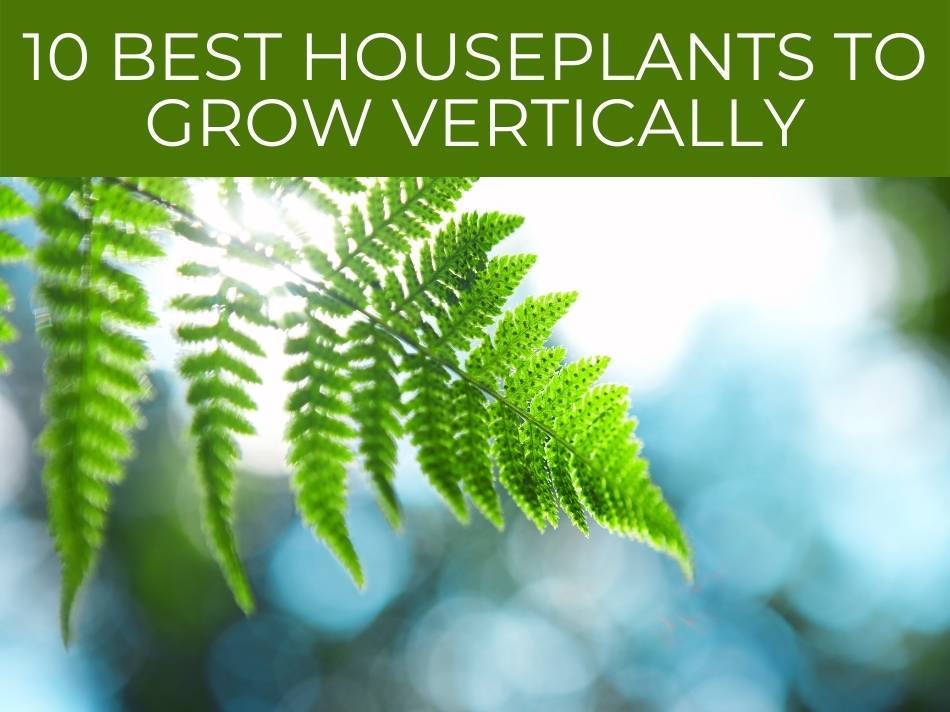
10 best houseplants to grow vertically
Ferns
Ferns are one of the most common vertical garden additions for several reasons: they’re beautiful, they’re easy to grow, and they’re adaptable to a variety of growing situations. There are lots of different kinds of ferns, so it’s up to you and which varieties you like best! Mixing and matching are always encouraged.
Pothos
Pothos will work great in your vertical garden, especially because they can spread fairly easier and fill any gaps you may have. They grow like vines and are known for their ability to thrive in pretty much any environment, even those that aren’t as forgiving in terms of light and water. Perfect for the beginner gardener or anyone who fancies low maintenance plants that are still beautiful!
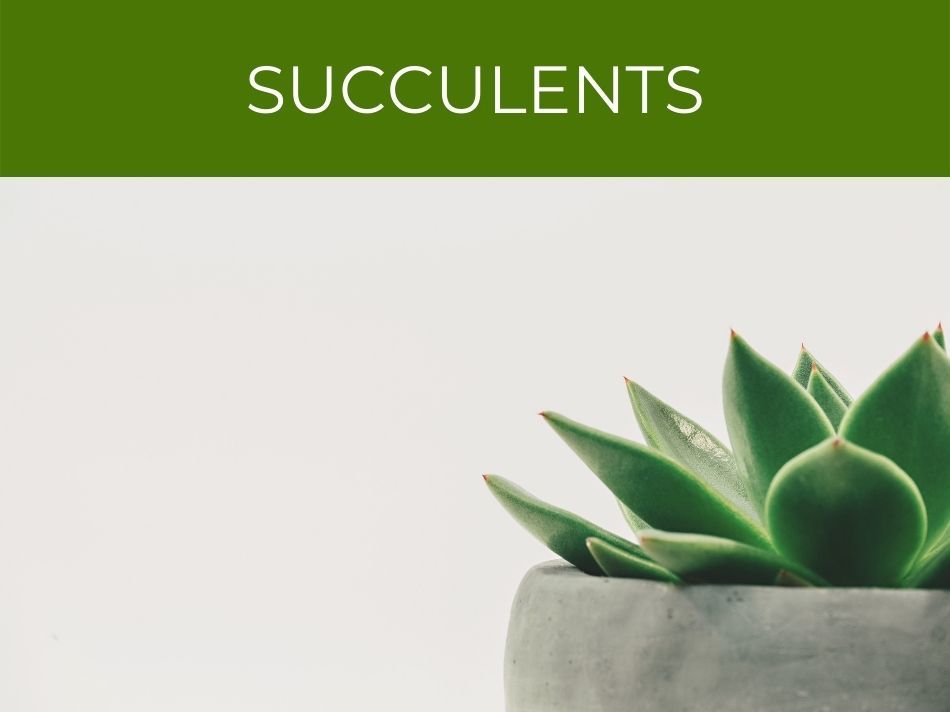
Succulents
Succulents have been really trendy the past few years for two main reasons: they’re adorable and they’re easy to take care of. These make them ideal for your vertical garden! There are so many different varieties, so you can really add some fun design and color to your garden when you use succulents. They come in all kinds of colors, shapes, and sizes, so you can Plus, most of them need very little water. The only thing you’ll want to keep in mind is that because lots of succulents are used to desert-like conditions, many of them thrive in environments with a lot of light. If your garden won’t get a lot of light, you can look for low-light varieties.
Dracaena
Dracaena can be a great and easy way to add a pop of color to your vertical garden without incorporating flowers. They typically grow upright so they’ll grow out nicely in a vertical design, and their leaves come in a variety of colors.
Hosta
If you live somewhere cooler and your gardening space gets a lot of shade, hosta would be a perfect addition to your vertical garden. Their leaves have beautiful, intricate designs, and you’ll also get to enjoy their beautiful flowers in the spring!
Lipstick plant
The lipstick plants are so named because of their bright red flowers that bloom several times throughout the year. They will add some striking color to your vertical garden, and even when they aren’t in bloom, the cascading green leaves are ideal for the vertical design.
Baby’s tears
Baby’s tears are typically used as ground cover, so this is another great plant you can use to fill in any gaps you may have. They’ll also add a different texture than many of the plants listed here because of their small bunches of leaves that won’t grow out too far, making them easy to maintain.
Begonias
If you’re looking to add flowers to your garden, begonias are a great choice. They typically come in pink, white, and light orange, and all varieties grow really well in a vertical setup. There are several different types, meaning that you can find various sizes depending on what kind of space you have, and all types will thrive in a vertical design.
Irises
Irises were maybe the most surprising find for flowers that grow well vertically, but the design does seem to suit them! They have long, thin, strap-like leaves that cascade beautifully when they grow in a vertical garden. The flowers themselves bloom fairly early in the spring and don’t last terribly long, but the time you do get to spend with them is well worth it.
Bromeliads
Bromeliads can thrive in very little soil, which makes them perfect for vertical gardens. The flowers come in many different colors and they bloom a long time, meaning they’ll add color to your garden for the long haul. They also have beautiful leaves that will look great even when the plants aren’t flowering.
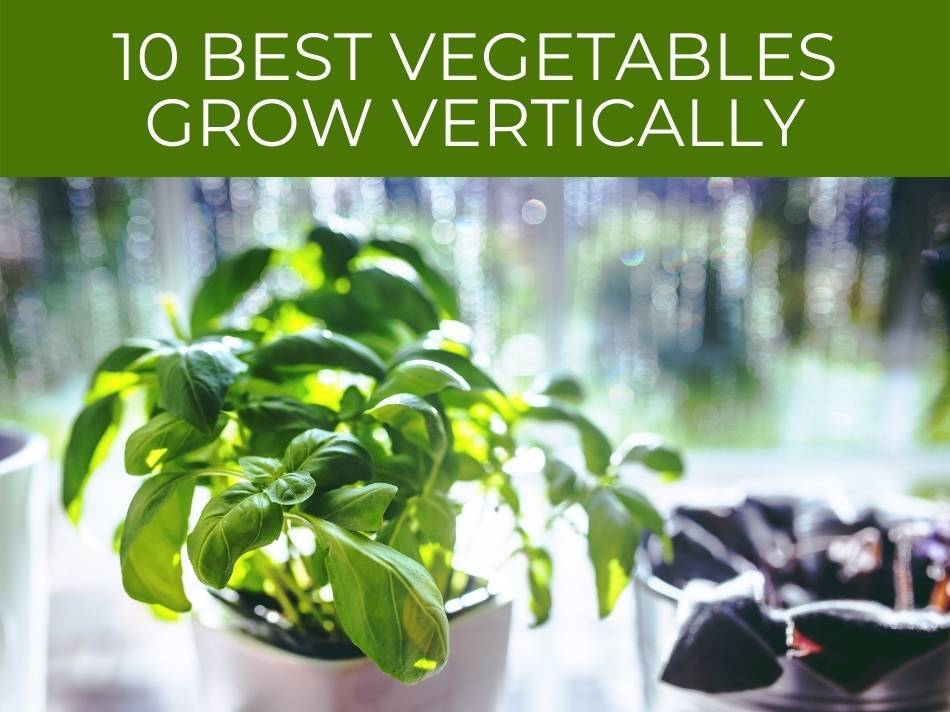
10 best vegetables grow vertically
Tomatoes
You can grow any tomatoes in a vertical garden, but smaller varieties such as cherry tomatoes will work really well. Because tomatoes grow vertically by nature, sticking them in a vertical garden is a pretty easy transition! Plus, the vines will curl nicely around whatever materials you decide to use, which always looks really beautiful.
Beans
Beans are super easy to grow, and each plant produces a good amount, making them ideal for a vertical garden. They’re also nice and light, so they won’t weigh the garden down. If you’re a bean fan, we’d recommend planting at least a few seeds!
Peas
Peas are very similar to beans in that they’re light, easy to grow, and prolific. Snap peas are our favorite, but any variety will do well in a vertical garden.
Carrots
Carrots are light and don’t require a lot of space to grow, making them ideal for a vertical garden! You can plant a bunch of them in a small space, and they’ll grow really well without taking over.
Mini cucumbers
Similar to tomatoes, regular cucumbers are hard to grow in a vertical garden, but the miniature variety works really well. They’re not too heavy, and they grow on vines similar to tomatoes, making them great vertical garden additions.
Radishes
Radishes are often overlooked in the gardening world, but they can add a nice crunch and flavor to many dishes. They grow really well in a vertical garden, and they’re great for beginners because they grow easily and without a lot of maintenance!
Mini onions
Mini onions are super tasty and fun to grow, and they work well for the vertical garden setup. It’s a great way to be able to grow onions without overloading your garden.
Herbs
Basil, mint, cilantro, and oregano will all flourish in a vertical garden. These plants are great for your first vertical garden especially because they grow easily and quickly, so you’ll feel like a pro. Plus, there are about a million recipes (food and drink alike) that incorporate at least one of these herbs, and there’s nothing like fresh herbs. Your dishes and drinks will taste that much better when you know that you’ve grown the herbs yourself in your own vertical herb garden!
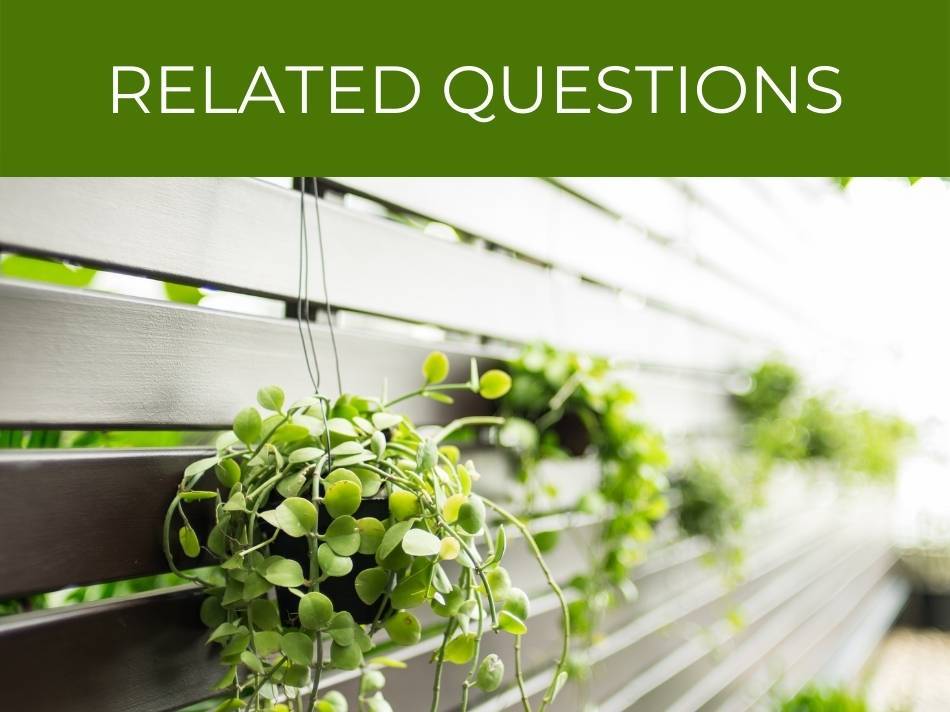
Related questions
How do I make my vegetable garden vertical?
Many vegetables grow really well in vertical gardens, so if you’re wanting to create a vertical garden that’s all vegetables, that’s no problem. You’ll want to make sure that the vegetables you grow are light and don’t require a ton of space, so things like squash, potatoes, and larger varieties of tomatoes will do better in a traditional garden. However, things like herbs, carrots, and cherry tomatoes are just some of the produce options that will grow perfectly in a vertical garden! It’s hard to take an already existing garden and transition it to a vertical design, so the vertical garden will be best for those who are wanting to create a new garden.
How do vertical gardens work?
Vertical gardens, as weird as it may seem, work just like your traditional in-ground garden. The plants will just grow in an outward direction instead of upward and will hang in a similar fashion to plants in hanging baskets that cascade down the sides. As long as your plants are getting enough light and water and nutrients, the vertical garden will operate just like a traditional garden would! Your plants won’t notice the difference between growing up or out as long as they have everything they need to thrive.


